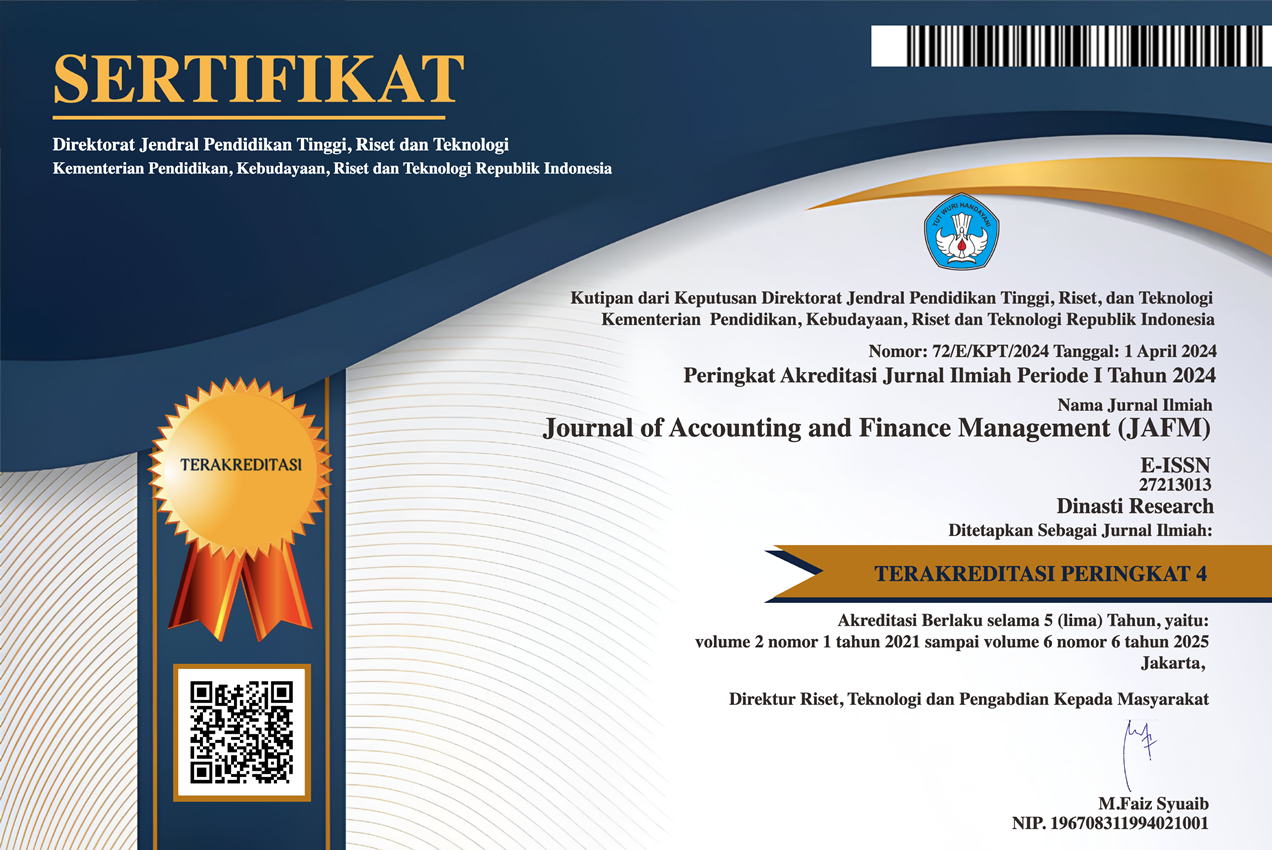The Relationship of Financial Literacy and Financial Inclusion in Attracting Student Interest to Become Customers Syariah Banking
DOI:
https://doi.org/10.38035/jafm.v4i1.190Keywords:
Islamic Banking, Financial Literacy, Financial Inclusion, Student Interest, Customers Syariah BankingAbstract
The presence of students in the world of Islamic banking as a young generation provides an opportunity for banks to continue to exist in the midst of existing competition. This study investigates how the influence of financial literacy and Islamic financial inclusion in attracting customer interest from among students. This research uses a type of quantitative research with statistical data. The number of respondents was 144 respondents who were students of the Islamic banking study program at the Parepare State Islamic Institute and Parepare Muhammadiyah University. Data analysis technique is a process used to manage research results in order to obtain a conclusion. Statistics is knowledge about data collection, data classification, data presentation, data management, drawing conclusions and making decisions based on certain problems. one sample t test, multiple linear regression test. Partial Test (t test), Simultaneous F Test and Coefficient of Determination Test. The results of the Financial Literacy research show that from the sample calculation values ??above, it is found that the average financial literacy is 43.2% of what is expected. Thus financial literacy is in the good category. Financial inclusion, shows that from the sample calculation value above, it is found that the average financial inclusion = 28.8% is in the good category. Interest in Using Islamic Financial Institutions, shows that from the sample calculation value above it is found that the average financial literacy is 21.6% of what is expected. The correlation coefficient is 0.804 with a significance of 0.000. Because the significance is 0.000 <0.05, Ho is rejected and H1 is accepted. This means that there is a positive and significant relationship between financial literacy and inclusion on the interest of Islamic Banking students at IAIN Parepare and Muhammadiyah Parepare University. The effect of financial literacy and inclusion on student interest in using Islamic financial institutions is 0.804. The calculated F-value is 62,932 with a significance level of 0.000. Because the P-Value <0.05, Ho is rejected or in other words the coefficients ?1 and ?2 affect Y together so that it can be said that the regression model.
References
Ansari, Y., Albarrak, M. S., Sherfudeen, N., & Aman, A. (2023). Examining the relationship between financial literacy and demographic factors and the overconfidence of Saudi investors. Finance Research Letters, 52(December 2022), 103582. https://doi.org/10.1016/j.frl.2022.103582
Cossa, A., Madaleno, M., & Mota, J. (2022). Financial literacy environment scan in Mozambique. Asia Pacific Management Review, 27. https://doi.org/10.1016/j.apmrv.2021.09.004
Gallego-Losada, M. J., Montero-Navarro, A., García-Abajo, E., & Gallego-Losada, R. (2023). Digital financial inclusion. Visualizing the academic literature. Research in International Business and Finance, 64(December 2022), 101862. https://doi.org/10.1016/j.ribaf.2022.101862
Jain, K. (2022). An insight into financial literacy of University faculties: A case study of University of Rajasthan employees, India. Social Sciences & Humanities Open, 5(1), 100262. https://doi.org/10.1016/j.ssaho.2022.100262
Kumar, P., Pillai, R., Kumar, N., & Tabash, M. I. (2022). The interplay of skills, digital financial literacy, capability, and autonomy in financial decision making and well-being. Borsa Istanbul Review. https://doi.org/10.1016/j.bir.2022.09.012
Lin, C. A., & Bates, T. C. (2022). Smart people know how the economy works: Cognitive ability, economic knowledge and financial literacy. Intelligence, 93(June), 101667. https://doi.org/10.1016/j.intell.2022.101667
Murshed, M., Ahmed, R., Al-Tal, R. M., Kumpamool, C., Vetchagool, W., & Avarado, R. (2023). Determinants of financial inclusion in South Asia: The moderating and mediating roles of internal conflict settlement. Research in International Business and Finance, 64(December 2022), 101880. https://doi.org/10.1016/j.ribaf.2023.101880
Ong, H., Wasiuzzaman, S., & Chong, L. (2023). Heliyon Digitalisation and financial inclusion of lower middle-income ASEAN. Heliyon, 9(2), e13347. https://doi.org/10.1016/j.heliyon.2023.e13347
Sekita, S., Kakkar, V., & Ogaki, M. (2022). Wealth, Financial Literacy and Behavioral Biases in Japan: the Effects of Various Types of Financial Literacy. Journal of the Japanese and International Economies, 64(January), 101190. https://doi.org/10.1016/j.jjie.2021.101190
Sharma, S. (2022). Enablers to Financial Literacy: A DEMATEL Approach. Procedia Computer Science, 214(C), 520–527. https://doi.org/10.1016/j.procs.2022.11.207
Sheng, Y., Chen, Z., Ali, S., Imdad, M., & Khalid, M. (2022). Borsa _ Istanbul Review Dynamic common correlated effects of fi nancial inclusion on foreign direct investment : Evidence from East-Asia and Paci fi c countries. Borsa Istanbul Review. https://doi.org/10.1016/j.bir.2022.12.002
Van Nguyen, H., Ha, G. H., Nguyen, D. N., Doan, A. H., & Phan, H. T. (2022). Understanding financial literacy and associated factors among adult population in a low-middle income country. Heliyon, 8(6), e09638. https://doi.org/10.1016/j.heliyon.2022.e09638
Downloads
Published
How to Cite
Issue
Section
License
Authors who publish their manuscripts in this journal agree to the following conditions:
- The copyright on each article belongs to the author(s).
- The author acknowledges that the Journal of Accounting and Finance Management (JAFM) has the right to be the first to publish with a Creative Commons Attribution 4.0 International license (Attribution 4.0 International (CC BY 4.0).
- Authors can submit articles separately, arrange for the non-exclusive distribution of manuscripts that have been published in this journal into other versions (e.g., sent to the author's institutional repository, publication into books, etc.), by acknowledging that the manuscript has been published for the first time in the Journal of Accounting and Finance Management (JAFM).




























